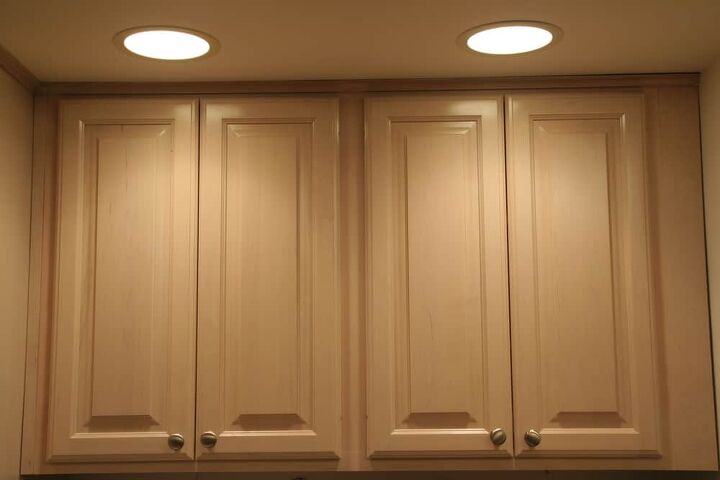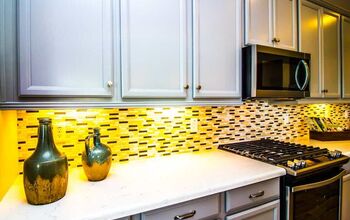How Far Should Recessed Lights Be From A Cabinet?

Recessed lighting is one of the most timeless ways to add a little mood to your room and highlight items in it. That’s why they’re so popular to put near memento cabinets. However, lights shouldn’t always be directly next to your cabinet. These lights are notoriously prone to problems if not spaces properly. So, how far should recessed lights be from a cabinet?
Install recessed lighting 12 to 18 inches away from cabinets for optimal illumination of your space and countertops. If using 4-inch cans, 12 inches from cabinets is enough, but 6-inch cans require more space. Make sure the recessed lights are also at least 12 inches apart from each other and between 1.5 and 3 feet from the wall.
Recessed lights are great, but knowing where to place them matters just as much as knowing that you want them. This guide will show you how to make the most of your lighting.
Do You Need to Hire an Electrician?
Get free, zero-commitment quotes from pro contractors near you.

Why Do Recessed Lights Need To Be Spaced Away From Cabinets?
Recessed lighting is regarded as one of the best lighting types when it comes to spreading light around a room, and it’s true. But how far should recessed lights be from a cabinet? These lights need proper spacing in order to look good; here’s why:
- If you don’t space them far enough away, you might end up with shadows being cast from your cabinets. This is a big issue that you need to be aware of. Cabinets are tall enough to block light from your ceiling. Unless you want unsightly shadows, you will need to space out those lights.
- If lights are placed too close together, it can also cause excessive lighting in your home. Trust me when I say that people tend to notice when there are glaringly bright lights almost stacked on top of one another in a room. It makes a room look stark and washed out.
- Lights that are placed too close to a cabinet can also cause issues with opening the cabinet door. You’d be surprised, but it happens. This is especially true when you’re dealing with cabinet moldings.
- Proper spacing will give your recessed lighting enough area to fully fill a room with light. Good spacing will also help make sure that the lighting you’re getting is even enough to make a difference. It’s just elegant.
Can You Install Recessed Lighting Near Insulation?
Recessed lighting can be installed near insulation, but there’s a catch. Your recessed lights need clearance. When we talk about clearance, we mean the distance from the insulation of the ceiling to the recessed lighting setup.
This distance needs a minimum of three inches in order to use standard can housing. If you don’t have this minimum clearance, you can’t use standard recessed lighting cans. In order for your lighting to be deemed safe, you will need to splurge for IC-rated cans.
IC-rated housing does not require the three-inch rule. Since IC-rated housing cans are meant to be used when insulation comes into contact with the can, you don’t have to worry about light clearance with these cans.
IC-rated housing is meant to be more resistant to heat and less likely to conduct heat throughout the structure. This will help prevent any issues that could arise with the potential of fire hazards. To find out more, check out your local building codes or read about IC rating here.
Where Should You Install Recessed Lighting?
Recessed lighting is a great choice for almost any home. If you are looking for a good option for open layout rooms, living rooms, dining rooms, or kitchens, it’s a good choice.
Recessed lighting does not do well, however, on slanted ceilings or vaulted ceilings. This is primarily due to the installation needs they have and the fact that they can make your ceiling prone to leaks.
How To Space Your Recessed Lighting Away From Cabinets
Now that we know the benefits of properly spaced lighting, it’s time to talk about how you should space those lights. These guidelines can help you make the most of your spacing:
- The larger the lights, the more space you are going to need away from the cabinets. For example, you might be able to space four-inch cans 12 inches away from your cabinet without issue. If you try to do the same with a larger six-inch can, it may give your home a more crowded look.
- Use your common sense. Smaller rooms will most likely need smaller spacing between lights, or at the very least, fewer lights. Larger rooms can afford wider spacing and may also require more lights than a typical room needs.
- If your cabinets have molding that connects them to the top of the ceiling, add a little extra space. This could need 15 to 18 inches of space, rather than 12. This prevents harsh shadows from being cast against the cabinetry.
Is Recessed Lighting Easy To Plan Out?
A good rule of thumb is that you should have a recessed light every four to six square feet of ceiling. So if you have a 24 square foot room, then you will need to have either six or four recessed lights. This makes it easy for your room to have that smooth, even lighting that recessed lighting is famous for.
Believe it or not, there is such a thing as too many lights in a room. Excessive numbers of recessed lights can make a room look stark or washed out. If your lights are excessive and poorly placed, you can also end up with dark corners due to the sheer number of shadows that your lights will cast.
Though this may be a little counterintuitive, it’s better to have too few recessed lights than it is to have too many. With too few, you can at least play it off as mood lighting. Excessive lighting doesn’t have that option.
Should You Use 4-Inch Or 6-Inch Recessed Lights?
This can be a matter of personal choice, but most people tend to find it easier to choose based on the size of a room. Four-inch lights take less space and tend to look more proportional in smaller rooms. Six-inch lights tend to provide more light, which makes them more appropriate for larger rooms.
The size of can you select also affects how far recessed lights should be from a cabinet. In general, you’ll need less spacing between 4-inch lights, typically about 12 inches from your cabinets will work. But, with 6-inch lights, you might need to space them closer to 18 inches away from cabinets.
How Do You Space Out Recessed Lights From Each Other?
How far recessed lights should be from a cabinet isn’t the only important spacing to consider. It’s also vital that the lights be spaced apart from each other appropriately.
The best way to space out your lights is to measure the height of your ceiling and divide it by two. That’s how much space you should have between your lights.
So if you have seven-foot ceilings, then your recessed lights should be around 3.5 feet away from one another. If you have 10-foot ceilings, then you should space them five feet away.
Hire A Professional Designer If You’re Unsure
For the most part, it should be easy to figure out your recessed lighting’s spacing. However, many people prefer to hire a professional interior designer, lighting expert, or architect to help them figure out where the best place to place their lights is. If you are worried about making the wrong decision or just need some guidance, professional advising can help.
Many home improvement stores actually offer this service for free, and that can be incredibly useful when it comes to planning your room. Of course, people who are getting these lights installed professionally can often ask their installers.
In Conclusion
Recessed lighting is a great way to add an elevated look to your kitchen and optimal light. However, it’s critical to space them accordingly, so you don’t run into any issues. Many designers deem 12 to 18 inches away from cabinets to be the sweet spot for recessed lighting.
When installing recess lighting, place cans at least 12 inches away from cabinets; this spacing works well for 4-inch cans. If using larger 6-inch cans, spacing them 18 inches from cabinets is a better option. Also, make sure that the cans are at least 12 inches apart from each other and 1 to 3.5 feet from the walls.
Do You Need to Hire an Electrician?
Get free, zero-commitment quotes from pro contractors near you.


Ossiana Tepfenhart is an expert writer, focusing on interior design and general home tips. Writing is her life, and it's what she does best. Her interests include art and real estate investments.
More by Ossiana Tepfenhart











![The 5 Best Angle Grinders – [2022 Reviews & Buyer's Guide]](https://cdn-fastly.upgradedhome.com/media/2023/07/31/9071326/the-5-best-angle-grinders-2022-reviews-buyer-s-guide.jpg?size=350x220)



![How To Reset A Whirlpool Cabrio Washer [In 5 Easy Steps!]](https://cdn-fastly.upgradedhome.com/media/2023/07/31/9076531/how-to-reset-a-whirlpool-cabrio-washer-in-5-easy-steps.jpg?size=350x220)











